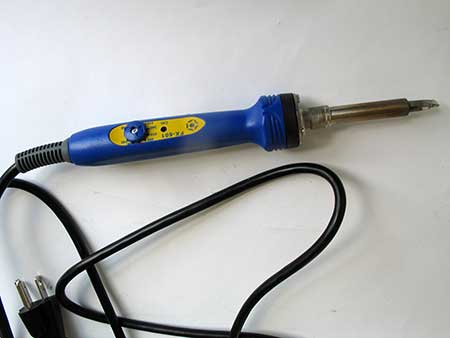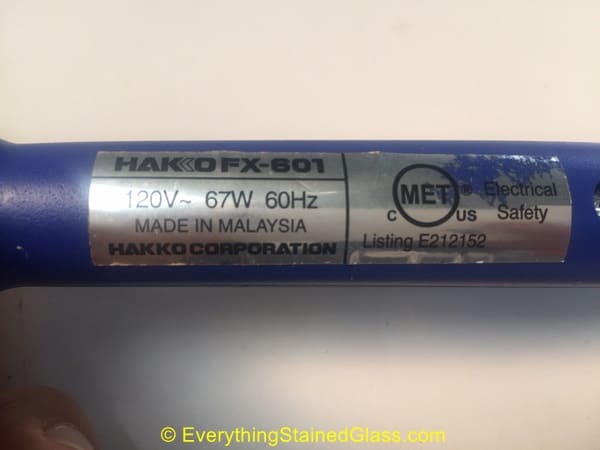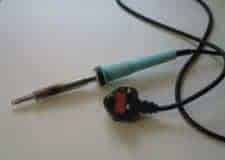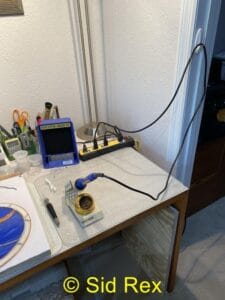Top Performing Soldering Iron
Your stained glass soldering iron is one of the most expensive items in your kit. And so it should be!
It’s a false economy to buy a cheap stained glass soldering iron and find that it doesn’t solder properly. There’s nothing more disheartening and it may put you off stained glass forever.
On this page you’ll find:
- helpful reviews of the best soldering irons around to help you choose wisely
- the important features to look out for before buying one
Before you even buy an iron I’m going to put the word ‘maintenance’ in your mind 🙂 Why would you spend out $$ and not take care of your iron? My Soldering Iron Maintenance Blueprint mini-class will set you off on the ‘peak performance’ road from the very start – and that’s not just the iron, it’s your soldering performance too.
Best Stained Glass Soldering Iron
Recommended
The Hakko FX-601 Soldering Iron
Starting at the top, we have the Queen of Stained Glass Soldering Irons, the Hakko FX-601 (paid link). This ticks all the must-have and wish-list boxes. I waited quite a while to buy mine but now I absolutely love its heat retention, adaptability and lightness.

Pros
- EFFICIENT. The temperature is thermostatically controlled and the iron contains the latest highly efficient ceramic heating element
- MAINTAINS TEMPERATURE. This ceramic heating element enables this soldering iron to reach temperature very quickly and to maintain it consistently over prolonged periods. The light flashes when the required heat is reached.
- NO COLD SPOTS. This avoids those annoying ‘cold’ spots that you sometimes suffer with other stained glass soldering irons when they attempt to recover heat.
- CHEAP TO RUN. The new ceramic heating technology is also cheaper to run than soldering irons with the more conventional temperature controlled tips.
- NOW CERTIFIED FOR USE IN EUROPE. At last! Hakko have now brought in a fully certified version of the FX-601 for the European market. Hoorah! You can see it here. Now you can just plug and go – no step-down transformer needed 🙂
Easily Adjustable
- MULTIPLE OPTIONS. Handy built-in control that can be adjusted to 6 different temperatures. For regular foil soldering tasks I use 360 or 410 – sometimes 460 if I’m doing something quickly. For leading projects I use 360. See this page for an important discussion on soldering iron temperatures.
- ADAPTABLE. Being able to change the tip temperature so readily adds versatility and means that the Hakko FX-601 iron can be used for all types of stained glass projects.
- LIGHT. The iron is very light which gives you lots of fine control over your soldering. If you’re doing hours of soldering you won’t get tired holding it.
Cons
There’s only a couple of occasional problems:
1. This hasn’t happened to me but I’ve heard it sometimes suffers from ‘burn on’. This is when the tip fuses to the iron barrel that holds it. To avoid this I suggest doing the following before you turn it on:
- loosen the nut
- turn both the tip and the barrel
- it’s worth applying a TINY amount of anti-seize grease
- then re-tighten the nut and turn it on
2. Some people dislike the long lead as it tangles. I love this feature as it allows me to easily reach around larger projects but if you don’t like the long wire there is a nifty solution below under the ‘Helpful Resources’ section.
Everything else about this iron is fantastic.
Rating
The Hakko FX-601 * professional quality soldering iron is lightweight, cheap to run, heats up extremely quickly and maintains temperature beautifully. 9 out of 10. (To be honest I’d give it 10/10 but I don’t think you’d believe me!!!)
WARNING: only buy Hakkos from reputable companies – preferably Hakko themselves. There are some very convincing fakes being made.
What is the difference between the Hakko 601-01 v 601-02?
I often get asked what the 02 and 01 stand for when buying a Hakko iron. The two numbers are used to differentiate between those irons suitable for the Japanese market (100V) and those suitable for the North American market (120V).

You have to check the sticker on the handle. I have the Hakko FX-601-02, pictured above – 120V-67W Made in Malaysia.
The sticker on the Hakko FX-601-01 says something like 100V-47W Made in Japan.
The 01 is 110V 47 watts.
The 02 is 120V 67 watts.
If you’re in North America, the 02 would be the one to get.
Here’s the information taken directly from Hakko Support in Japan – you can’t get more official than that!:
“FX601-01 is 100V for our domestic market (Japan), and FX601-02 is 120V for USA.”
Good news if you’re in Europe/UK – there’s now a brand new version out made specifically for the European and UK market*. I use a step-down transformer so that I can use my north American one in the UK but this won’t be needed for these new irons.
The model number for this new product is:
FX601-17 and it’s 230V.
A Readers Experience of this Hakko Iron:
“I have upgraded my soldering iron with the Hakko you recommended and it makes the process so much better. The proper tools really do make a difference. I feel that my pieces look better – there’s a lot less frustration with each step.“
Polly Smith-Blackwell USA in New York State/Chemung County.
*Just so’s you know, if you click and buy through the link within 24 hrs I get a small % from Amazon, (not you!). Thanks in advance but no worries if you have a local store – I’d always support them first 🙂
Other Stained Glass Soldering Irons
The Weller 100 Watt Iron

The Weller 100W Soldering Irons are just right for those who are starting out and who want a very good iron at a decent price. I used one for years and years until I bought the Hakko FX-601.
I still regularly use them as an alternative.
Comes with a 3/8″ 700 degree tip.
Pros
– These soldering irons reach temperature in a couple of minutes.
– Weller 100 soldering irons are easy to use for beginners as the tip is thermostatically controlled. This means you don’t need to adjust the temperature while you’re soldering nor do you need an expensive rheostat (separate temperature controller).
– It’s the most popular stained glass soldering iron and many accessories are easily available.
– The iron is lightweight and easy to maintain.
Cons
-Very occasionally this iron will experience cool spots. This is when the temperature drops and it will need to rest for a minute or two to regain its heat.
-You have to change the tip to change the temperature, rather than turn a dial. This is time consuming and an additional expense.
Rating
The Weller 100 is lightweight and well balanced. It works well with different types of solder. These soldering irons are great for those not wanting to spend on the Hakko. 8 out of 10.
The Studio 100 Iron

The Studio 100 Iron is great value but I’m not sure if that is enough to recommend it.
The main difference between this and the Hakko FX-601 above is price, temperature flexibility and running efficiency.
The Studio 100 soldering irons have a temperature controlled tip which has a set (rather than adjustable) temperature – normally around 750F – which the iron reaches and then shuts off.
Once heat has been lost from the tip it has to turn itself on again. This causes ‘cold’ spots stopping it melt the solder.
Cons
– More costly to run as the thermostat than the irons with ceramic heating elements.
– Cold spots experienced.
Rating
The Studio 100 soldering irons come with a one year manufacturer’s warranty and have replacement tips in various sizes available to buy.
However, with commonly experienced cold spots I would pay the extra for the Weller 100. 6.5 out of 10.
What To Look Out For In A Stained Glass Soldering Iron
There are three key things to consider when looking at stained glass soldering irons:
First, temperature.
Your iron should have a heat capacity of between 80 and 200 watts.
– The exception to this rule is irons with the ceramic heating element, like the Hakko FX-601 above, which is a far more efficient technology and therefore needs less wattage.
– When you are soldering stained glass, you want the tip to reach and maintain a certain temperature to melt the solder evenly.
Second, weight.
You might be using the iron for prolonged periods of time, so its weight and the balance between the handle and tip are important.
Thirdly, versatility.
There are different tips and temperatures needed for various soldering tasks.
– The best irons can be adapted to suit all types of projects. – A standard ¼” tip is great for copper foil or lead came projects, whereas smaller tips are better for decorative soldering.
– Being able to adjust the temperature of your iron means that it can be set at the melting point of the solder you’re using and give you perfect results.
Helpful Resources
A tip from reader Sid Rex if you find the long Hakko FX-601wire gets tangled, hang the cord on a hook. This also takes a bit of weight away from the already light iron. Thanks for the tip Sid.

This is a useful 2mins 30 second video explaining some of the different tips you can buy for stained glass soldering irons. It tells you which ones are best for which kind of project.
Video explaining the types of tips available for soldering irons
Question from a Reader:
Q. I have the hakko 601-02 solder iron, love, Love, LOVE it. having a hard time finding small tips, what am I looking for as I can’t find the right ones?
A. You want a chisel tip – for this iron it’s the T19 range, shape D on this page: (none of the links below are paid links)
https://www.hakko.com/english/tip_selection/series_t19.html#type_d
You can buy different sizes here:
https://www.tequipment.net/Hakko/T19-D32/Tips/
or here at Anything in SG:
https://www.anythinginstainedglass.com/tools/ironsHakko.html
I’d try a couple out and see which width works best for you. It depends what you’re doing, too. Small delicate tasks are better tackled with a smaller tip.
There’s a page focusing on soldering iron temperature questions here
Find out about other stained glass tools for the Tiffany technique here.


Pls describe format for your on line class. Is it like a series of youtube videos? Or?
Interested in the lead course. Thx
Thanks for your question Norma. My classes consist of a series of videos taking you through a starter project so that you learn all the processes thoroughly.
The videos aren’t currently downloadable but that will change in the near future. There is no cut off point and you can access the course at all times to work through at your own pace.
I hope that explains it. There’s a 30 day refund so you could try and see if it works for you.
Let me know if you have any more questions.
I have just bought a Hakko iron after using a very old iron given to me. What should I do to season it before I use it?
You don’t have to do anything as the tips come pre-tinned Lyn. When you finish each session, let the iron cool slightly and then cover with solder.
Hope that helps and enjoy your new iron 🙂
All the comments about soldering irons have been spot on. I made my first three windows (leaded glass) using a very old and heavy iron, and when I wanted to use copper foil I bought a Studio Pro. After of the problems mentioned by others I bought a Weller with a temperature control and it was quite satisfactory for both lead and foil. Then I succumbed to the advertising for the Hakko and it was the best money I have spent on stained glass tools. I love the quick warm up, the consistent temperature and the light weight. I am dissatisfied with the stiff cord and it does tend to dictate the position of the iron in your grip. That is minor compared to the benefits, but I do hope Hakko is planning a more flexible cord in the future, as it is a superior iron.
So glad you thought the investment in the Hakko was worth it George. It’s great to hear that my recommendations are true for others as well as to me. Thanks to taking the time to post 🙂
This is such a practical and useful article. Thank you. I’m an absolute beginner in glass but worked in metals my whole life.
Great to hear Mikki, thanks. Have fun with your new craft 🙂
The X-Tronic 3020-XTS solder iron station is a good option for those who experience back pain during soldering work. Such can be the case when it comes to the small circuit board projects that require close concentration.
I’ve had a look James and can’t quite see how it would help a back… I haven’t heard of the soldering iron manufacturer either but that doesn’t mean it isn’t any good, just that I don’t know it.
Thanks for your suggestion.
Hi milly,
Hate to admit it but it is not a case of getting long in the tooth, I have arrived!! Mid eighties, going strong and still loving my Stained glass projects. i have just completed a course on Leading which will keep me busy going forward.
Your recent Article on Soldering was of particular interest to me. Both informative and enlightening. I keep a file with articles such as Soldering, and would dearly love to get hold of a copy.
Kindly advise me if this would be possible and what steps need to be taken.
Sincerely,
John.
Happy arrival John! 🙂 I’m delighted to hear that you’re enjoying stained glass and that it’s keeping your on your toes.
I have a few articles on soldering so I’m not sure which one you mean. You can sort through them here and Copy and Paste any you find helpful. Sorry I don’t have them in any other format.
Soldering lead:
https://everythingstainedglass.com/tag/soldering-lead-came
Soldering copper foil (you can learn from both as they’re the same principles):
https://everythingstainedglass.com/tag/soldering
I hope that helps.
In case it is of any interest, I am in South Africa, and have just ordered a new Hakko from our local Hakko agent who import direct from Japan. The invoice was for a Hakko FX601-11….which I queried as I still have spares for my existing 601, and was told that it is the model made for S.A. i.e. 220 mains voltage. I’ve been assured that all spares will fit. I do not have to use a converter as I did with the older 456 model.
It IS of interest, yes! Thanks for this additional information Beth, very helpful for SA readers 🙂
Hi,
Really useful article…thanks. I bought the Hakko in the USA a couple of years ago as they didn’t do one for the UK market at that point. So I had to buy a transformer to use it, but it was well worth it as it’s a really great soldering iron for all the reasons you’ve said. For years I had used the Weller 100W and originally they were great – reliable and kept to temperature. However, since the manufacture of these irons and replacement tips moved from Germany to Mexico I have found that they have a tendency to overheat and you can easily melt the lead came. So that’s another reason for me to use the Hakko.
When I saw that Hakko had brought out a UK version, I was tempted to buy another one but as the US version is half the price so I’ll just buy another one when I’m next over in the States, as I already have the transformer.
Glad you concur with my assessment Carole. I too bought a transformer, which does the job perfectly. Agree that there’s no point splashing out on a new European version – unless this packs up and I can’t get one from the US 🙂
Hi Milly, I just bought a Hakko Fx 601-02. I want to tin the tip the proper way and at what temperature. What do you recommend?
Congrats! I have a whole page on iron temperatures here: https://everythingstainedglass.com/hakko-fx-601temperature-question
I hope you enjoy your iron.
Thanks Millie for the Hakko review!
In some countries you can only buy the FX-600 model, which runs at lower temperatures than the FX-601. In Australia here (on 240 V) they only supply the FX-600. After doing some research, I see that buy the fx-600 and convert it to an fx-601 by replacing the tip and tip enclosure.
I saw this mentioned on the Hakko site, go to hakko.com and search for fx-600, then go to the bottom of the page. I also had this confirmed by email.
This way I don’t have to buy an overseas model 601 and use a transformer. I’m just about to order mine (:
Cheers
Oh that’s really useful information to learn, thanks Lu. Thanks too for sharing it here so that others can benefit from it.
I had to order the 601 conversion tip and enclosure, and the extra 601 tips, from the USA as they don’t sell the 601 tips here in Australia. And in case anyone is wondering, no you don’t lose any power from it being a 600 model – and yes I had this confirmed by email from Hakko.
After conversion the temperatures will be 40 degrees higher than than each of the markings on the 600.
Thanks for the extra information for Australian readers Lu, it really helps.
I’m new to stained glass, and my first soldering iron is the Studio Pro – It’s “just ok.” I’m going to invest in the Hakko once I can afford to! I frequently experience “cold spots” with my Studio Pro and it is SO frustrating – I’m fighting with “perfecting” my solder lines and this does not allow me to make nice and neat solder lines for the most part. When I can, it’s usually a “fluke.” I find that my Studio Pro iron does not maintain it’s temperature very well at all. It’s either too hot or too cold and usually one extreme or the other.
Thanks for your comments Tana, they’re very helpful for others thinking of buying a Studio Pro stained glass soldering iron. Cold spots are the bane of good soldering!
Absolutely LOVE my Hakko! Lightweight, versatile, awesome iron. I’ve been doing glass for 18 years – 2 years ago, I switched to this iron. I can’t believe how much better my soldering looks. Check amazon prices.
Wow, nice to know that even after 18 years, a different tool DOES make a difference 🙂
I have a studio pro as well. Debating between the Weller and Hakko now.
I’m old school been at it for nearly 40 years and have been using Hexacon all the time. Is this outdated? Are these Hakko better then a Hexacon? Maybe I’m out of date on my irons.
It’s fantastic that you’ve found a soldering iron that works well for you Dean. I’m all for people sticking with what they know if it works for them 🙂
No Dean you are right you will in my opinion ever find a more strong consistency than a Hexagon.You need a adjustable reostat but totally worth it. I just bought the Hako 601 fx & there is a thin ceramic stem I like the performance but then the ceramic,stem cracked in half after using 2 weeks.
Hi Dean, we’ve used Hexacon for more than 50 years. nothing better than the 250 for large foil projects. by large I mean 3-5 hours soldering time. i did buy a Hakko , and I like it for small stuff and repairs. its good for old lead patching type repairs. the problem is not the length of the cord, but it’s stiffness. the iron is so light the cord easily walks it all over the bench.
stick with your hexacons. Can’t go wrong! Geoff Caldwell Sunflower Glass Studio , Stockton, NJ
I bought one of these recently and have been very impressed with the quick heat up and the consistent temperatures. But I do have a couple of issues with it. First, the grip area is not an ergonomic design. It is basically round and a bit large at that. It can get tiring. But the cord itself is stiff. This causes the unit to rotate in your hand which MAY not be how you want the tip oriented. I suppose you can fix this by changing the orientation of the tip in the unit… but frankly, I only think about it when the FX-601 is hot.
This may be the best unit available, but I’d like to see some improvements for the FX-701.
Thanks for your considered thoughts on the Hakko FX-601 Kraig. I hadn’t noticed the wire causing the iron to swivel but it sounds annoying. Like you say; the best can always be improved!
The remady is relatively simple: I had the original cord replaced with the rubber jacket cord in one case and with the woven jacket (from an iron) in the other case.
Have it done by an electrician.
Many thanks Milly for your tips and comments.
Janusz
Great idea Janusz, thanks for commenting. Off we all rush to our local electricians!
Kraig – my only complaint about the Hakko is the same as yours. My other older irons have a very flexible cord and the Hakko’s is quite stiff, difficult to manage. Other than that, it took me a while to adjust to a new iron but I now love it. Been doing stained glass for almost 40 years and it’s hard to adjust to changes in tools and material – always seems the old tools were better made and lasted longer, and availability of glass is just frustrating. Still love it and so glad a student of mine told me about Milly!
Hi Milly,
Thank you for doing this review on soldering irons it was very helpful. I’ve been using the Weller 100 iron for many years, always experiencing cool spots and being very frustrated. I thought the Weller 100 was the best iron available but having to deal with cool spots I’ve started to look for an alternative. After reading your review I’ve decided to purchase the Hakka FX-601 but will continue to use the Weller 100 as a backup.
Milly you always come through with a great piece on Stained glass that helps educate us all.
You are a great teacher, anyone in Stained glass can learn something from you.
Thank you, always your student
Robert P.
You won’t regret splashing out on the Hakko FX-601 I promise. I still use my Wellers – 100W and 200W – but mainly for lead work. The Hakko is used for everything else!
Lovely to hear from you Robert, and to see that you’re still making stained glass. Hoorah!
I am retired and do Stained Glass as a weekend hobby. I bought the Hakko-FX 601 a few years ago. Within the first year the rubber part that is on the cord where the cord meets the back of the iron started sliding down the cord. I took electrical tape and taped the part to the back of the iron to keep it from sliding down. Because of the constant twisting of the iron when you are soldering, that did not work. As a result a short time later it shorted out. Luckily I had it on a GFI outlet and it tripped. I am grateful there wasn’t a fire. I tried to get ahold of the party that I bought it from on Amazon with no luck. A $70.00 mistake! I do want to say that before the short happened it was a good iron.
Wow, thanks for the warning Dave. I’ve never heard that happening to anyone else but it’s certainly worth keeping an eye out for.
Hi, im sold on the Hakko FX-601 Soldering Iron, but unsure about the step-down transformer – having tried to look into them there is a whole range of options – please could you advise exactly what you use, or what i should look out for.
I use a 240V to 110V 300W Voltage Converter.
It’s a bit more expensive than some of the others but I never like to push electrics to the limit. It’s been great, no problems with leaving on for ages. I always tend towards more robust for electrical goods.
You can get cheaper ones but can’t be left on… for example the Mercury Step-Down Voltage Converter. It says it: “enables a 110-120Vac device from the USA to be powered from a 230-240Vac UK mains outlet. Allows use of US electrical equipment with 2 or 3 pin plugs in the UK. This transformer is not suitable for constant use and cannot be used for more than an hour at a time and is not silent as it makes a slight humming noise.”
This would put me off, especially for an item such as a soldering iron that heats up to high temperatures. Having said that, I’m not an expert on transformers (!). I would spend the extra to be safe and sure.
I hope that helps.
The Marlin website is closed. Is there another place to look at for your recommendation?
Love all of your information! Have only been doing stained glass since January 2015. Taking my classes from an instructor who teaches in two different counties thru their Recreation and Parks departments. Have seven classes per year, now have expanded to twice a year.
I have all my goodies in a rolling backpack. After one set of classes you needed to buy your own tools if you wanted to continue. My instructor has needed to “borrow” my tools from time to time in classes. She likes to crumble that ‘you have everything’, gotta love her, lol!
Thanks for all your advice!
Lola from Richmond, Virginia
Thanks for the heads up Lola. I’ve changed the Hakko stained glass soldering iron to this link now; let me know if you’re still having problems with it. If you’re not in the US the link will try and find an equivalent product which may not be the same one I’m afraid. We can’t change that at the moment.
I love the idea of a rolling backpack full of stained glass goodies! You sound like a professional Teaching Assistant 😉
Thanks so much Milly!!!
I am a newbie at Stained glass and just found your web page.
You advise on soldering rings helped me finally finish my first piece.
I love your site!
The links you include and videos are great.
thanks again,
Trudy
BC Canada
That’s so nice to hear Trudy, thanks for taking the time to comment. Glad your stained glass is improving 🙂
Thanks for such helpful advice
You’re welcome Gourlay, thanks for your comment.
Nice one.. Thanks for sharing.. I just have one question in my mind.. Which is the best among the three models and best temperature recommended for stained glass?
I particularly like the Hakko FX-601 but still use the Weller 100 too. I would recommend either of these.
As to the temperature – I use 410 for copper foil work and 360 for lead came on the Hakko and tip number 8 for copper foil and number 7 for lead came on the Weller.
I hope that helps and thanks for your question Edward.
How AWESOME!!! You put all this together and i am so excited… expert answets at my fingertips! Thank you Millie
You’re most welcome Gail. I’m glad you’re finding my website useful.